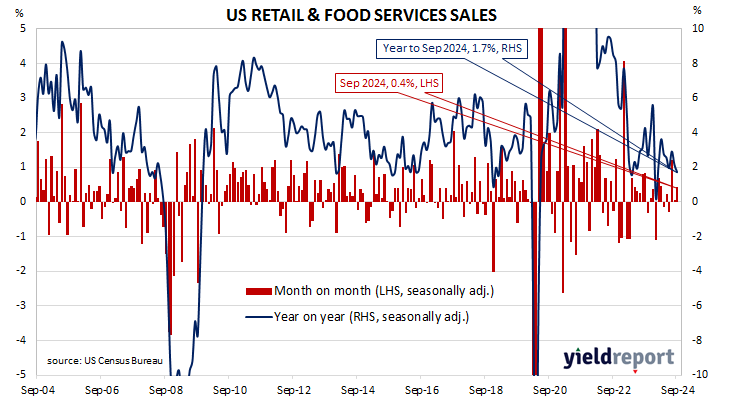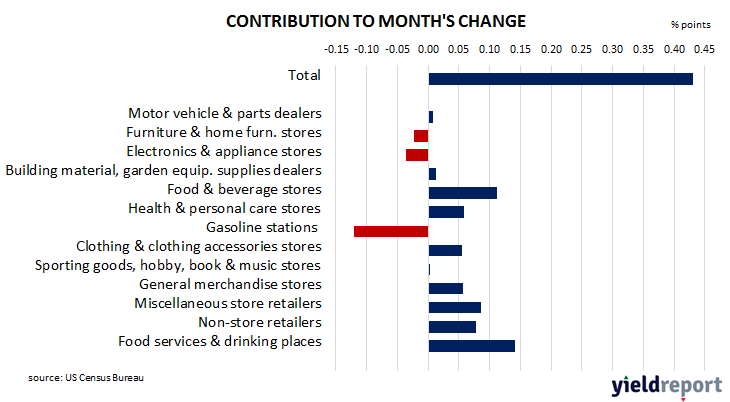Summary: US retail sales up 0.4% in September, more than expected; annual growth rate slows to 1.7%; Westpac: US consumers more resilient than previously expected; US Treasury yields up; rate-cut expectations soften; Westpac: control group sales up 0.7%; higher sales in ten of thirteen categories; food services & drinking places largest single influence on month’s result.
US retail sales had been trending up since late 2015 but, commencing in late 2018, a series of weak or negative monthly results led to a drop-off in the annual growth rate below 2.0%. Growth rates then increased in trend terms through 2019 and into early 2020 until pandemic restrictions sent them into negative territory. A “v-shaped” recovery then took place which was followed by some short-term spikes as federal stimulus payments hit US households in 2021. However, growth rates have slowed significantly since mid-2022.
According to the latest “advance” numbers released by the US Census Bureau, total retail sales increased by 0.4% in September. The result was greater than the 0.2% increase which had been generally expected as well as August’s 0.1% rise after revisions. However, on an annual basis, the growth rate slowed from August’s revised rate of 2.2% to 1.7%.
“Retail sales came in above market expectations, suggesting the consumer is more resilient than previously expected,” said Westpac economist Pat Bustamante.
The figures came out on the same morning as August’s industrial production figures and US Treasury bond yields rose across a steeper curve. By the close of business, the 2-year Treasury yield had gained 4bps to 3.98%, the 10-year had increased by 8bps to 4.10% while the 30-year yield finished 6bps higher at 4.36%.
In terms of US Fed policy, expectations of a lower federal funds rate in the next 12 months softened, although at least another five 25bp cuts priced in. At the close of business, contracts implied the effective federal funds rate would average 4.655% in November, 18bps less the current rate, 4.515% in December and 4.22% in February. September 2025 contracts implied 3.515%, 131bps less than the current rate.
“Headline retail sales were up by 0.4%, but well above the average pace in 2024 so far of 0.2% per month,” added Bustamante. “Excluding auto and gas, retail sales were up 0.7%, a reading at the top of the recent range. Control group sales, a guide of the overall consumer spending, was also up by 0.7%, to leave the three-month growth in this category at 1.6%, double the pace seen in Q2 and the highest since Q1 2023.”
Ten of the thirteen categories recorded higher sales over the month. The “Food services & Drinking places” segment had the largest single influence on the overall result as it rose by 1.0% over the month and contributed 0.14 percentage points to the total.
The non-store segment includes vending machine sales, door-to-door sales and mail-order sales but nowadays this segment has become dominated by online sales. It accounts for around 17% of all US retail sales and it is the second-largest segment after vehicles and parts.



